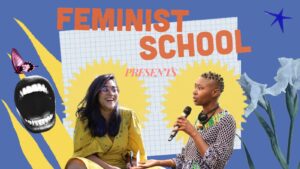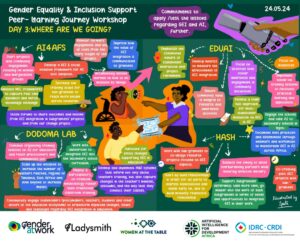In graduate school, I began to be fascinated by the ‘black box’ of organizations, the peculiar ways through which organizations digest gender equality laws and policies and put out something that looks quite different from what one might expect. Connecting these two worlds – how organizations worked and whether or not women could access opportunity systems – happened most clearly for me while working at BRAC in Bangladesh in the 1990s. I saw first-hand how the values that shaped the organization in its early years and resulted in benefits to destitute people, later inhibited its ability to recruit women staff because those values were gender- biased.
In the 1990s Bangladesh cultural context, it was easy and acceptable for men to carry out field work at night, ride bicycles and motorbikes, and live singly in villages; for women, it was not. So, in effect, women had to fit into a system that was made to fit men. In a staff survey we conducted in 1994, we asked BRAC staff, “must women become men to succeed?” Most male BRAC staff said that was not the case but many women contested their view. BRAC has since embarked in an organization- wide program to uncover and address institutional biases and discriminatory norms. Informal norms and rules become so deeply embedded in an organization that they remain unnoticed, ignored or invisible. They become insidious and dangerous perpetrators of gender discrimination and over time, they add up to a culture of inequality. This affects life within organizations for women and men. It also affects how effectively the organization can catalyse change in the communities in which it works. Gender at Work helps people inside organizations identify these deeply embedded gender-biased norms or “deep structures”, and then chip away at them. We work with a wide range of organizations, networks and movements around the world. In India, we supported Dalit women to break the strangleholds that prevent them from fully using and benefiting from the MNREGA scheme , a national rural employment program. In South Sudan, we worked with civil society organizations fighting gender-based violence; they started involving men in their battle and exploited the power of radio. In South Africa, we partnered with organizations to integrate HIV&AIDS issues into their responses to gender-based violence.
Uncovering deep structures and changing them is not easy. It is a complex and dynamic process for everyone involved, throwing up tough questions and requiring brave answers. This honesty is enabled in a number of ways – by building trust, by ‘unleashing’ capacity at the individual and collective levels, through strategic learning and evaluation, and by building knowledge.
Our capacity building includes Gender Action Learning (GAL), a robust and intensive process that guides organizations and/or groups within organizations to develop strategies and processes that will end discrimination against women in formal systems and organizations. Together, participants examine the deep structures that hold inequality in place and then, we help develop a collective project to change these deep structures, or at least move in that direction. This involves peer-learning workshops, shared accountability, individual coaching and mentoring from a G@W facilitator, and the development of approaches, tools and writing. It involves thought, mind-body work, and plenty of laughter.
When Lok Samiti partnered with Gender at Work in India, they wanted to fundamentally transform the composition of their Union. Not only did they want to increase the number of Dalit women by 25%, they also wanted to ensure that Dalit women come into positions of leadership in the union. Now, 50% of the membership and leadership includes Dalit women. Hospersa, a union of health workers in South Africa, participated in an action-learning process in 2011 to reframe their thinking on how the union listens to its members. Today, Hospersa addresses gender issues in their collective bargaining efforts. It has set up a sexual harassment policy; and it engages with and provides insights into national policies relating to gender & HIV/AIDS and TB.
Organizations can also go through learning and evaluation from a gender equality and rights-based perspective. They do this using the G@W Framework , an analytical matrix which helps examine how change happens by looking at inter- connections among different change domains and collective impact. In 2013, Gender at Work developed a tool for FAO to assess whether there was gender inclusion in the agricultural and rural poverty reduction policies of their member states. We helped identify how the policies in a given country were addressing poverty and equality issues, their impact, gaps and incoherencies, and areas of priority action. The tool we developed will be used to provide country-wide “snapshots”, track changes in national policies over time, and identify policy options and possible corrective measures among FAO member countries.
One of the most satisfying experiences of strategic learning was when we worked with organizations in South Africa to guide them on innovative writing / story-telling techniques to identify shared strategies. The stories that emerged became a book. Before we knew it, the book had sold thousands of copies and was being read by people who didn’t even usually read. The language, they said, was their own. Building knowledge remains one of our priorities because it allows us to move forward in this direction and contribute to the larger area of work around gender. We do this continuously and we try to reach people in multiple ways. We develop Collaboratories for people working on different aspects of gender inequality, write books, run contests, and produce articles, power-point presentations and other media. Our Board and Associates are profoundly interested in ending discrimination against women in formal systems and organizations, and they spend a significant amount of their time and energy sharing their knowledge and ideas.
By trying to transform cultures of inequality in individual, innovative and meaningful ways, we’re aiming to end gender discrimination. Join us at our website, get in touch via email and stay in touch on Twitter, Facebook and LinkedIn.
by ARUNA RAO
Aruna Rao is the Co-founder and Executive Director of Gender at Work, a transnational network of individuals and organizations that build knowledge and practice to end discrimination against women and advance cultures of equality. She is an expert in the field of gender and development and has consulted widely with a range of government, academic and development agencies. This was originally published in Fem2pt0.



